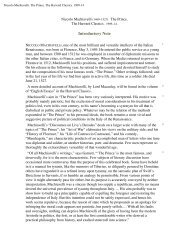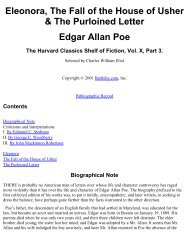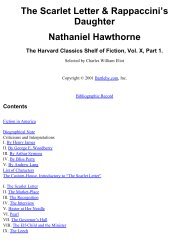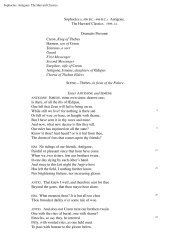Notre Dame de Paris - Bartleby.com
Notre Dame de Paris - Bartleby.com
Notre Dame de Paris - Bartleby.com
Create successful ePaper yourself
Turn your PDF publications into a flip-book with our unique Google optimized e-Paper software.
The family had inherited from the brothers Packet the fief of Tirechappe, which was held of the Bishop<br />
of <strong>Paris</strong>, and the twenty-one houses of which had, since the thirteenth century, been the object of<br />
countless litigations in the Ecclesiastical Court. As owner of this fief, Clau<strong>de</strong> Follow was one of the<br />
“seven times twenty-one” seigneurs claiming manorial dues in <strong>Paris</strong> and its suburbs; and in that capacity<br />
his name was long to be seen inscribed between the Hôtel <strong>de</strong> Tancarville, belonging to Maître François le<br />
Rez, and the College of Tours, in the cartulary <strong>de</strong>posited at Saint-Martin <strong>de</strong>s Champs.<br />
From his childhood Clau<strong>de</strong> Follow had been <strong>de</strong>stined by his parents for the priesthood. He had been<br />
taught to read in Latin; he had early been trained to keep his eyes down-cast, and to speak in subdued<br />
tones. While still quite a child his father had bound him to the monastic seclusion of the Collége <strong>de</strong><br />
Torchi in the University, and there he had grown up over the missal and the lexicon.<br />
He was, however, by nature a melancholy, reserved, serious boy, studying with ardour and learning<br />
easily. He never shouted in the recreation hour; he mixed but little in the bacchanalia of the Rue du<br />
Fouarre; did not know what it was to dare alapas et capillos laniare, 45 and had taken no part in that<br />
Stu<strong>de</strong>nts’ riot of 1463, which the chroniclers gravely record as “The Sixth Disturbance in the<br />
University.” It rarely happened that he jibed at the poor scholars of Montaigu for their “cappettes,” from<br />
which they <strong>de</strong>rived their nickname, or the exhibitioners of the Collége <strong>de</strong> Dormans for their smooth<br />
tonsure and their tricoloured surcoats of dark blue, light blue and violet cloth—azurini coloris et bruni,<br />
as the charter of the Cardinal <strong>de</strong>s Quatre-Couronnes puts it.<br />
On the other hand, he was assiduous in his attendance at the higher and lower schools of the Rue<br />
Saint-Jean <strong>de</strong> Beauvais. The first scholar whom the Abbé <strong>de</strong> Saint-Pierre <strong>de</strong> Val caught sight of,<br />
established against a pillar in the Ecole Saint-Vendregesile, exactly opposite to his <strong>de</strong>sk when he began<br />
his lecture on Canon Law, was invariably Clau<strong>de</strong> Follow, armed with his inkhorn, chewing his pen,<br />
scribbling on his threadbare knees, or, in winter, blowing on his fingers. The first pupil Messier Miles<br />
d’Isliers, doctor of ecclesiastical law, saw arrive breathless every Monday morning as the door of the<br />
Chef-Saint-Denis schools opened, was Clau<strong>de</strong> Follow. Consequently, by the time he was sixteen, the<br />
young cleric was a match in mystical theology for a Father of the Church, and in scholastic theology for a<br />
Doctor of the Sorbonne.<br />
Having finished with theology, he threw himself into canonical law and the study of the <strong>de</strong>cretals.<br />
From the Magister Sententiarum he had fallen upon the Capitularies of Charlemagne, and in his<br />
insatiable hunger for knowledge had <strong>de</strong>voured <strong>de</strong>cretal after <strong>de</strong>cretal: those of Theodore, Bishop of<br />
Hispalis, those of Bouchard, Bishop of Worms, those of Yves, Bishop of Chartres; then the <strong>de</strong>cretal of<br />
Gratian, which came after Charlemagne’s Capitularies; then the collection of Gregory IX; then the epistle<br />
Super specula of Honorius III. He thoroughly investigated and ma<strong>de</strong> himself familiar with that vast and<br />
stormy period of bitter and protracted struggle between Civil and Ecclesiastical Law during the chaos of<br />
the Middle Ages, a period which Bishop Theodore began in 618, and Pope Gregory closed in 1227.<br />
The <strong>de</strong>cretals assimilated, he turned his attention to medicine and the liberal arts; studied the science of<br />
herbs and of slaves; became an expert in the treatment of fevers and contusions, of wounds and of<br />
abscesses. Jacques d’Espars would have passed him as physician; Richard Hellain, as surgeon. He ran<br />
through the <strong>de</strong>grees of Licentiate, Master, and Doctor of Arts; he studied languages: Latin, Greek, and<br />
Hebrew—a thrice inner sanctuary of learning seldom penetrated at that time. He was possessed by a<br />
veritable rage for acquiring and storing up knowledge. At eighteen, he had ma<strong>de</strong> his way through the










